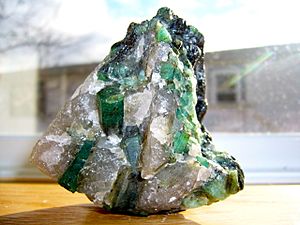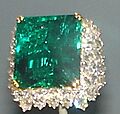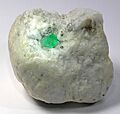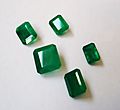Emerald facts for kids
Quick facts for kids Emerald |
|
|---|---|

Emerald crystal from Muzo, Colombia
|
|
| General | |
| Category | Beryl variety |
| Formula (repeating unit) |
Be3Al2(SiO3)6 |
| Crystal symmetry | (6/m 2/m 2/m) – Dihexagonal Dipyramidal |
| Unit cell | a = 9.21 Å, c = 9.19 Å; Z = 2 |
| Identification | |
| Formula mass | 537.50 |
| Color | Green shades |
| Crystal habit | Massive to well Crystalline |
| Crystal system | Hexagonal (6/m 2/m 2/m) Space group: P6/mсc |
| Cleavage | Imperfect on the [0001] |
| Fracture | Conchoidal |
| Mohs scale hardness | 7.5–8 |
| Luster | Vitreous |
| Streak | White |
| Diaphaneity | Transparent to opaque |
| Specific gravity | Average 2.76 |
| Optical properties | Uniaxial (-) |
| Refractive index | nω = 1.564–1.595, nε = 1.568–1.602 |
| Birefringence | δ = 0.0040–0.0070 |
| Ultraviolet fluorescence | None (some fracture filling materials used to improve emerald's clarity do fluoresce, but the stone itself does not) |
An emerald is a type of mineral and a variety of beryl. It is known for its beautiful green color. The emerald is the birthstone for people born in May. It is one of the most valuable gems, like the ruby, opal, topaz, diamond, and sapphire.
Contents
What Makes Emeralds Special?
When jewelers grade colored gemstones like emeralds, they look at four main things. These are often called the four Cs: color, clarity, cut, and carat weight.
For most colored gemstones, color is the most important part. But for emeralds, clarity (how clear it is) is almost as important as its color. A truly great emerald must have a pure green color and also be very clear.
In the 1960s, the jewelry industry in the United States changed what they called an "emerald." They started including green beryl that contained a metal called vanadium. This means that some "vanadium emeralds" sold in the U.S. are not seen as true emeralds in places like the UK and Europe. To show the difference, people in America often use names like "Colombian emerald" for the traditional kind.
Color of Emeralds
The color of a gem is looked at in three ways: hue (the actual color, like green), saturation (how strong the color is), and tone (how light or dark the color is).
Emeralds can be found in colors from yellow-green to blue-green. But the main color must always be green. Yellow and blue are often seen as extra colors in emeralds. Only gems that are medium to dark green are called emeralds. Lighter green gems are simply called green beryl.
The best emeralds have a tone that is about 75% dark. (Imagine 0% is clear and 100% is black.) Also, a great emerald will have a strong, bright green color. If an emerald looks grayish-green, it means the color is dull.
Clarity of Emeralds
Emeralds often have many tiny marks or cracks inside them. These are called inclusions or fissures. Unlike diamonds, where jewelers use a special magnifying glass (10x magnification) to check clarity, emeralds are usually checked with just the eye.
If an emerald has no visible inclusions when you look at it normally, it is considered perfect. Stones without any surface cracks are very rare. Because of this, almost all emeralds are treated to make them look clearer.
The inclusions and cracks inside an emerald are sometimes called jardin. This is a French word for garden, because they can look like moss. These tiny marks are unique to each emerald. They can even be used to identify a specific stone, like a fingerprint!
The most valuable emeralds are clear to the eye, have a strong green color, and only a little bit of any other color (like blue or yellow).
Emeralds are often cut into a rounded shape called a cabochon because of their natural marks. But if they are cut with flat surfaces, they are usually given an oval shape or the special "emerald cut." This is a rectangular shape with many flat surfaces around the top edge.
How Emeralds Are Treated
Most emeralds are treated with oil after they are cut. This helps to fill in tiny cracks that reach the surface. This makes the emerald look clearer and stronger. Cedar oil is often used because it has a similar way of bending light as emeralds. Other liquids, like synthetic oils, are also used.
These treatments are usually done in a special vacuum chamber with a little heat. This helps the stone's tiny pores open up so it can soak up the oil better. In the U.S., companies must tell buyers if an emerald has been treated with oil.
Using oil is a common and accepted practice in the gem world. However, oil-treated emeralds are worth less than untreated emeralds of the same quality. Other treatments, like using green-tinted oil, are not allowed.
Gems are graded on how much they have been treated: none, minor, moderate, and highly enhanced. These grades show how much the gem's look has been improved, not how clear it is. Even a gem graded "none" might still have some visible marks.
Where Emeralds Are Found
Emeralds have been mined for a very long time. People in Egypt mined them as far back as 1500 BCE. They were also found in India and Austria by the 14th century CE.
Today, Colombia is the biggest producer of emeralds in the world. It provides 50–95% of all emeralds, depending on the year and quality. Emerald mining in Colombia has grown a lot in the last ten years. The three main mining areas are Muzo, Coscuez, and Chivor. Colombia is also where you can find rare "trapiche emeralds." These have cool ray-like patterns made of dark impurities.
Zambia is the second largest producer of emeralds. Their mines near the Kafubu River produce about 20% of the world's high-quality emeralds.
Emeralds can be found in many other countries around the world. These include Afghanistan, Australia, Brazil, Canada, China, Ethiopia, Germany, Madagascar, Mozambique, Nigeria, Pakistan, Russia, South Africa, Tanzania, the United States, and Zimbabwe. In the U.S., emeralds have been found in states like North Carolina and Montana. In Canada, emeralds were found in the Yukon in 1997.
Man-Made Emeralds
Scientists have learned how to grow emeralds in a lab. These are called "synthetic" or "created" emeralds. They can be made using different methods. One method is called "hydrothermal" growth, and another is "flux-growth." There's even a way to grow a layer of emerald onto a colorless beryl stone.
The first successful way to make emeralds in a lab was developed by Carroll Chatham. Another big producer of lab-grown emeralds was Pierre Gilson Sr., who started selling them in 1964. Gilson's emeralds are usually grown on small pieces of natural colorless beryl. They grow slowly, about 1 millimeter per month. A typical seven-month process can create emerald crystals that are 7 millimeters thick.
Lab-made emeralds are often called "created" because they have the same chemical and gem properties as natural emeralds. The U.S. Federal Trade Commission (FTC) has strict rules about this. They say that if you call something "laboratory-grown" or "synthetic," it must have almost the same look, feel, and chemical makeup as the natural stone.
Emeralds in History and Culture
Emeralds have been important in many cultures throughout history.
- Emerald is the traditional birthstone for May.
- It is also the traditional gemstone for the astrological sign of Cancer.
A funny story about emeralds comes from a historian named Brantôme in the 1500s. He talked about the many amazing emeralds that the Spanish, led by Cortez, brought back from Latin America. On one of Cortez's most beautiful emeralds, he had words carved into it: "Among those born of woman there hath not arisen a greater" (from the Bible, Matthew 11:11). This referred to John the Baptist. Brantôme thought carving on such a perfect natural gem was wrong. He even believed this act caused Cortez to lose a very valuable pearl and might have even led to the death of King Charles IX of France.
In India, the main god of the famous Meenakshi Amman Temple in Madurai is the goddess Meenakshi. People traditionally believe her statue is made of emerald.
Related pages
Images for kids
-
A 5-carat emerald from Muzo with a hexagonal shape.
-
The Gachalá Emerald, one of the largest gem emeralds in the world, weighing 858 carats. It was found in 1967 in Gachalá, Colombia, and is now at the National Museum of Natural History in Washington, D.C.
See also
 In Spanish: Esmeralda para niños
In Spanish: Esmeralda para niños












